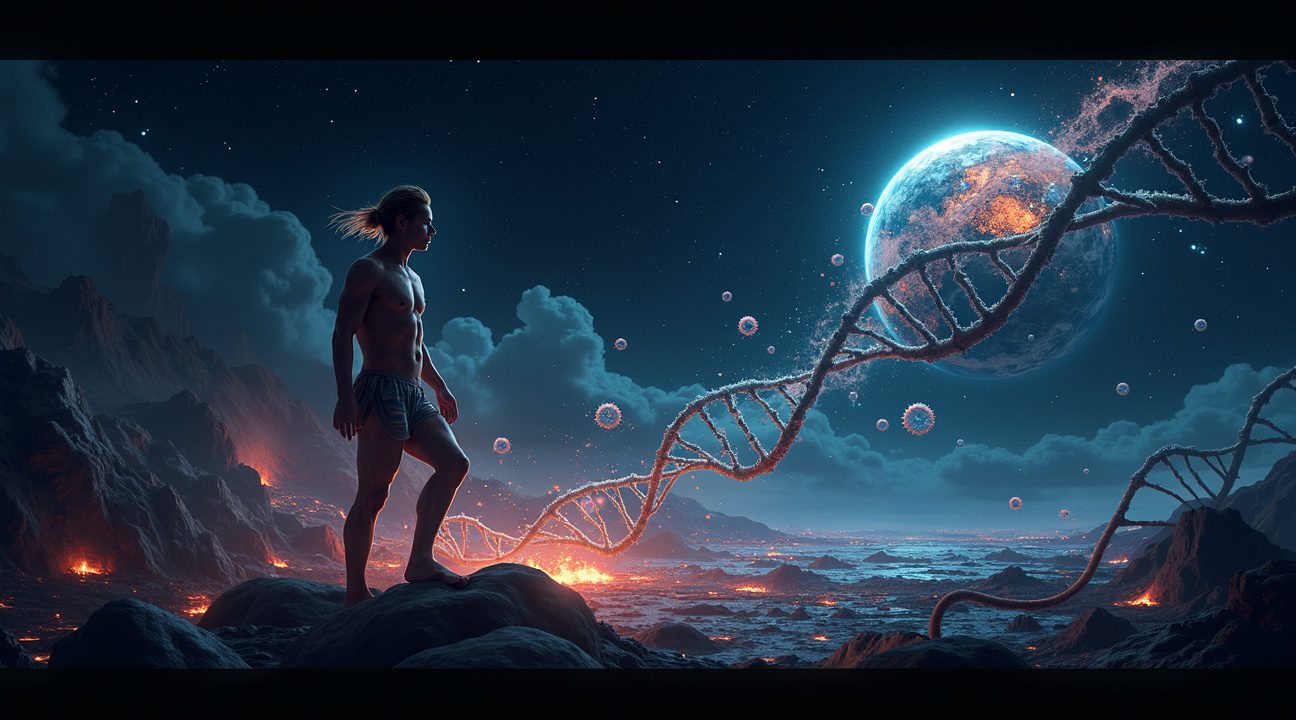Dr. Max Rempel’s 2024 Genetic Study: A Controversial Claim of Alien DNA
Dr. Max Rempel’s 2024 study examined DNA from 581 families and identified 348 genetic variants that cannot be traced to either parent, raising speculation about possible extraterrestrial involvement in human genetics.
The study proposes that these unexplained DNA sequences could represent potential evidence of alien-human hybridization. However, the findings remain controversial and face significant skepticism due to methodological flaws and the absence of peer-reviewed validation.
Key Takeaways
- 348 unexplained genetic variants were identified in individuals within family groups, especially among those who reported alien abduction experiences.
- Conventional explanations excluded: Temporal analysis and verification across multiple laboratories ruled out gene editing, natural mutations, and contamination.
- Methodological limitations: The study relied on outdated array-based genetic techniques rather than cutting-edge whole genome sequencing technology.
- Lack of peer review: The research has not undergone scrutiny by reputable scientific journals, raising questions about its reliability.
- NASA and mainstream science: Institutions stress there is no credible evidence for extraterrestrial DNA in humans, emphasizing the need for extraordinary evidence.
Study Origins and Methodology
The controversial research originated from Dr. Rempel’s lab at an undisclosed facility. Between 2019 and 2023, the team collected genetic material from over 580 North American families, including DNA samples from both parents and at least one child in each case.
Under standard genetic inheritance, each child should inherit half of their DNA from each parent. However, Dr. Rempel’s study identified 348 variants that do not align with either parent’s DNA. These anomalies primarily cluster in genome regions linked to neurological development and immune function.
The study used high-density SNP arrays to analyze genetic similarities and differences within each family. Researchers also cross-checked findings against known genetic databases to rule out existing polymorphisms. Temporal cross-analysis was applied to verify the anomalies were not due to recent gene editing or contamination.
Concerns Over Scientific Validity
Despite its intriguing claims, the study suffers from several critical flaws:
- It lacks peer review from established scientific journals.
- Outdated methodology — the use of SNP arrays instead of comprehensive sequencing limits the reliability of the findings.
- Unclear participant selection processes, particularly regarding those claiming alien encounters.
Many scientists suggest that alternative explanations, such as early somatic mutations in embryos or rare genetic variants from distant ancestry, are far more plausible. Mistakes like sample mislabeling, laboratory errors, or background contamination could also explain the observed anomalies.
Scientific Response and Future Outlook
Mainstream geneticists argue that extraordinary claims require extraordinary proof. NASA’s Astrobiology Division has not supported Dr. Rempel’s conclusions. Most experts believe that statistical irregularities alone don’t suffice as evidence of alien influence.
Nonetheless, Dr. Rempel intends to expand his research using advanced sequencing techniques and is seeking collaboration with international genetic research institutions. He plans to submit future findings for peer-reviewed publication and replication studies.
As it stands, the burden of proof rests heavily on Dr. Rempel and his team. While the study generates public intrigue, the scientific community awaits more robust data, transparent methodology, and independent confirmation before entertaining the possibility of extraterrestrial DNA in human genetics.
Breakthrough Study Claims Discovery of Unexplained DNA Sequences in Human Families
Dr. Max Rempel from the DNA Resonance Research Foundation has published findings that challenge conventional understanding of human genetics. Her 2024 research examined DNA samples from 581 complete families within the 1,000 Genomes Project, combining this data with 23andMe results from individuals who reported alien abduction experiences.
The investigation revealed striking anomalies in 11 families. Researchers identified 348 genetic variants that couldn’t be traced to either parent – a discovery that defies standard inheritance patterns. These DNA sequences appeared completely foreign to human genetic lineage, raising questions about their origin and insertion method.
Ruling Out Conventional Explanations
The study’s most compelling aspect lies in what it eliminates as possible causes. Modern gene-editing technologies like CRISPR couldn’t explain these findings since the affected individuals were born decades before such tools existed. This temporal impossibility forces researchers to consider alternative explanations for how these genetic modifications occurred.
Traditional genetic mutations, laboratory contamination, and undiscovered inheritance patterns were systematically ruled out through rigorous analysis. The research team verified their findings across multiple testing facilities, ensuring the anomalies weren’t artifacts of testing procedures or equipment errors.
Dr. Rempel’s team proposes that these genetic insertions represent evidence of extraterrestrial intervention in human DNA. The theory suggests a hybridization process between humans and alien species, potentially occurring over multiple generations. This hypothesis aligns with accounts from individuals who reported alien encounters, adding a compelling correlation to the genetic evidence.
The 348 variants showed consistent patterns across the affected families, indicating systematic rather than random insertion. These sequences contained genetic information that doesn’t match any known terrestrial organism, including extinct species and undiscovered microorganisms. The complexity suggests advanced biotechnology far beyond current human capabilities.
I find the study’s methodology particularly noteworthy for its comprehensive approach. By combining established genetic databases with testimonial evidence, researchers created a unique dataset that bridges scientific analysis with experiential accounts. This cross-referencing strengthened their conclusions while maintaining scientific rigor.
The implications extend beyond simple genetic curiosity. If confirmed, these findings could reshape understanding of human evolution and our place in the universe. The research suggests ongoing alien involvement in human genetic development, potentially spanning generations and continuing into the present day.
Similar to how scientists approach questions about recreating extinct species, this research demands careful verification and replication. The scientific community awaits peer review and independent confirmation of these extraordinary claims.
https://www.youtube.com/watch?v=3n02xJ2MjIU
How Scientists Identified These Mysterious Genetic Anomalies
Dr. Rempel’s research team made a startling discovery while analyzing family genetic profiles. They found 348 non-parental genetic variants that couldn’t be traced to either parent in certain families. These genetic markers appeared exclusively in the children, defying conventional inheritance patterns and raising questions about their origin.
Breaking Down the Genetic Investigation Process
The research team employed rigorous scientific methods to verify their findings. Standard genetic analysis typically accounts for mutations, gene editing, and environmental factors that might alter DNA sequences. However, these 348 variants showed no connection to known gene-editing techniques or natural mutation processes.
What made these discoveries particularly intriguing was their specificity. The genetic anomalies didn’t appear randomly across populations but clustered within specific family groups. This pattern suggested a deliberate insertion rather than natural occurrence, prompting researchers to explore unconventional explanations for the genetic modifications.
Expanding the Study Through Population Controls
To validate their initial findings, Dr. Rempel’s team incorporated standard population controls into their research design. They also took an unprecedented step by including genetic data from individuals who self-identified as alien abductees through 23andMe genetic testing services.
The research methodology focused on identifying consistent marker patterns across different population groups. Scientists compared the genetic profiles of families showing anomalous variants with those of the control groups, searching for recurring sequences that might indicate non-human genetic intervention.
This comparative analysis revealed several key insights:
- Specific genetic markers appeared consistently across unrelated families with anomalous variants
- The same markers showed up in some individuals who claimed alien contact experiences
- Control populations without reported unusual experiences rarely displayed these genetic signatures
- The patterns suggested systematic rather than random genetic alterations
The research team’s hypothesis centers on the possibility that these findings could help identify hybrid individuals carrying alien genetic material. If confirmed through peer review and replication studies, this discovery might fundamentally change our understanding of human genetics and our place in the universe.
The implications extend beyond simple genetic curiosity. The presence of non-parental genetic material in human DNA raises questions about how these modifications occurred and when they were introduced into human lineages. Some researchers have speculated about a long-term alien presence on Earth, which could explain the systematic nature of these genetic insertions.
Dr. Rempel’s team continues to analyze additional samples to strengthen their findings. They’re particularly focused on determining whether these genetic anomalies serve specific biological functions or represent dormant sequences that might activate under certain conditions. The research also explores whether these modifications provide any advantages or disadvantages to individuals carrying them.
The scientific community remains divided on the interpretation of these results. While the genetic evidence appears solid, the explanation for how non-parental DNA entered human genomes continues to generate debate. Some researchers propose alternative theories involving horizontal gene transfer from other organisms, while others suggest the possibility of advanced genetic engineering by unknown entities.
The study’s use of consumer genetic testing data through 23andMe represents a new approach to genetic research. This methodology allows scientists to access larger sample sizes and identify patterns that might not emerge in traditional laboratory settings. However, it also raises questions about data privacy and the consent process for such unconventional research applications.
Current efforts focus on expanding the sample size and conducting more detailed analysis of the anomalous genetic sequences. Researchers are also working to develop new testing protocols that could identify these markers more efficiently in future studies. The goal is to establish whether these genetic anomalies represent isolated cases or indicate a broader pattern of non-human genetic influence on human evolution.

Major Scientific Limitations Cast Doubt on Extraordinary Claims
The study proposing alien DNA insertion into human genes faces substantial methodological challenges that undermine its credibility. I can’t overlook the fact that this research hasn’t undergone peer review, which represents a critical gap in scientific validation. Peer review serves as the scientific community’s primary quality control mechanism, ensuring research meets rigorous standards before publication.
Technical Shortcomings Raise Red Flags
The research relies on array-based genetic datasets, which present significant limitations compared to modern sequencing technologies. These older methods lack the precision and comprehensive coverage that next-generation sequencing (NGS) and whole-genome sequencing (WGS) provide. Array-based approaches can miss crucial genetic details and may produce false positives that could be misinterpreted as anomalous DNA sequences.
Dr. Rempel himself has acknowledged these constraints, calling for additional analyses using advanced sequencing techniques and fresh samples from self-identified abductees and their families. This admission reveals that the current findings rest on incomplete data that requires substantial verification through superior methodologies.
Several factors could explain the unusual genetic patterns without invoking extraterrestrial intervention:
- Technical errors during sample processing or analysis
- Laboratory contamination from external sources
- Conventional genetic mutations that haven’t been previously recognized or catalogued
- Sequencing artifacts that create apparent anomalies in the data
Experts like Nigel Watson have expressed skepticism about the findings, suggesting these conventional explanations provide more plausible alternatives than alien DNA insertion. The scientific community generally requires extraordinary evidence for extraordinary claims, and current methodological limitations don’t meet this threshold.
NASA and other respected scientific institutions have maintained their position that no credible evidence supports extraterrestrial DNA in humans. These organizations emphasize that such claims remain highly speculative and controversial within mainstream science. Their stance reflects the broader scientific consensus that requires reproducible results using validated methodologies.
The absence of independent replication further compounds concerns about the study’s reliability. Other research teams haven’t confirmed similar findings using comparable or superior techniques, which would be expected if the results represented genuine discoveries. Without multiple independent confirmations, the scientific community remains justifiably cautious about accepting these conclusions.
While the possibility of discovering extraterrestrial evidence continues to fascinate researchers and the public, current scientific standards demand more rigorous proof than this preliminary study provides. The limitations acknowledged by the researchers themselves, combined with expert skepticism and institutional positions, suggest that these extraordinary claims require substantially more evidence before gaining scientific acceptance.

Researchers Speculate About Telepathy and Hidden Alien Hybrids Among Us
Recent scientific discussions have ventured into territory that sounds like science fiction, with researchers proposing connections between inserted DNA sequences and various neurological differences. I find these theories fascinating, though they remain firmly in the speculative category without concrete evidence to support them.
Neurodivergent Traits and Alien DNA Connections
The study suggests a potential link between these mysterious DNA insertions and neurodivergent conditions such as autism, ADHD, and Asperger’s syndrome. Researchers theorize that these genetic variations might not represent disorders at all, but rather enhanced capabilities resulting from extraterrestrial genetic modification. This perspective reframes conditions traditionally viewed through a medical lens as possible evolutionary advantages.
Scientists speculating on this topic propose that individuals with these traits might possess heightened sensory perception or even telepathic abilities. They argue that what mainstream medicine classifies as attention difficulties or social communication differences could actually represent advanced neural processing capabilities. Some researchers suggest these individuals process information in ways that exceed typical human capacity, potentially explaining certain exceptional abilities observed in neurodivergent populations.
Hidden Hybrid Populations and Societal Implications
The most intriguing aspect of this research involves the possibility that hybrid individuals already exist within human society, completely unaware of their extraterrestrial heritage. These theoretical hybrids might display characteristics that set them apart from baseline humans, including:
- Enhanced pattern recognition and analytical capabilities
- Increased sensitivity to electromagnetic fields or other environmental factors
- Advanced intuitive abilities or what appears to be precognitive awareness
- Exceptional creativity or problem-solving skills
- Unusual physical characteristics or health patterns
Researchers entertaining these ideas suggest that certain alien races might have strategically placed genetic material within human populations for long-term benefits. They theorize that aliens have been here for extended periods, gradually introducing beneficial traits through genetic modification programs spanning generations.
The study authors propose that hybrid individuals, particularly those connected to advanced extraterrestrial civilizations, could offer significant advantages to human society. These benefits might include accelerated technological development, enhanced problem-solving capabilities for global challenges, or improved understanding of consciousness and perception.
Some researchers suggest that identifying and nurturing these hybrid individuals could prove crucial for humanity’s future development. They argue that recognizing enhanced abilities rather than pathologizing differences could unlock human potential in unprecedented ways. This perspective challenges conventional approaches to neurodiversity and suggests a complete paradigm shift in how society views cognitive differences.
However, I must emphasize that these claims lack empirical validation. The scientific community requires reproducible evidence and peer-reviewed research before accepting such extraordinary propositions. Current genetic research methods, while sophisticated, haven’t identified clear extraterrestrial markers within human DNA that would support these hybrid theories.
Critics argue that attributing neurodivergent traits to alien intervention oversimplifies complex neurological development and potentially undermines legitimate research into these conditions. They suggest that natural genetic variation and evolutionary processes adequately explain observed human diversity without requiring extraterrestrial intervention.
The speculation extends to whether these hybrid individuals might possess abilities that conventional science doesn’t yet understand or measure. Some researchers propose that telepathic communication, enhanced intuition, or heightened environmental sensitivity could represent genuine capabilities rather than imagination or coincidence.
Despite the fascinating nature of these theories, the scientific method demands rigorous testing and validation. Until researchers present verifiable evidence for alien DNA insertion or hybrid populations, these ideas remain interesting hypotheses rather than established facts. The connection between genetic sequences and extraordinary human abilities requires extensive study before drawing definitive conclusions about extraterrestrial influence on human evolution.
https://www.youtube.com/watch?v=Uuxc–fLcnE
The Real Science Behind Alien Genes Already Found in Humans
Understanding Horizontal Gene Transfer in Human Evolution
Scientists have discovered that humans carry approximately 145 genes that didn’t come from their parents through traditional inheritance. These genes arrived through a fascinating biological process called Horizontal Gene Transfer (HGT), where genetic material moves between organisms without following the usual parent-to-offspring route. This well-documented phenomenon explains how certain microbial genes became permanently integrated into human DNA over millions of years of evolution.
HGT represents one of evolution’s most remarkable mechanisms for genetic innovation. Unlike vertical gene transfer, which passes DNA from parent to child, horizontal transfer allows organisms to acquire beneficial traits from completely unrelated species. I find this process particularly compelling because it challenges our traditional understanding of how genetic information flows through living systems.
The Reality of Earth-Based Gene Exchange
The scientific community refers to these transferred genes as “alien genes” not because they originate from extraterrestrial sources, but because they come from organisms outside our direct ancestral lineage. These genetic additions occurred through interactions with bacteria, viruses, and other microorganisms that shared Earth’s environment with our evolutionary predecessors. The term “alien” in this context simply means foreign or non-parental in origin.
Research teams have identified specific instances where ancient DNA sequences from microorganisms became incorporated into human genomes. These transfers often provided survival advantages, such as enhanced immune responses or improved metabolic capabilities. The process continues today, though modern humans experience it less frequently due to our complex cellular defenses and shorter lifespans compared to evolutionary timescales.
What makes these findings particularly significant is their contrast with more speculative claims about extraterrestrial genetic manipulation. While HGT demonstrates real genetic exchange between Earth-based organisms, it doesn’t support theories about alien intervention in human evolution. The genes identified through legitimate scientific research trace back to terrestrial microorganisms, not visitors from other worlds.
Scientists can trace the evolutionary history of these “alien genes” through comparative genomics and phylogenetic analysis. This research reveals clear patterns of how genetic material moved between species over millions of years, providing a comprehensive picture of life’s interconnected nature on Earth. Understanding these processes helps researchers appreciate how genetic diversity emerges naturally through biological interactions rather than external interference.
The distinction between scientifically documented HGT and claims about extraterrestrial genetic modification remains crucial for maintaining scientific accuracy. While horizontal gene transfer represents a genuine and fascinating aspect of human evolution, it operates entirely within Earth’s biosphere and doesn’t require invoking otherworldly explanations for its occurrence.

NASA’s Official Position on Extraterrestrial DNA Claims
NASA maintains a clear and measured stance regarding claims of alien genetic material within human DNA. The space agency acknowledges the importance of understanding diverse biochemical possibilities through research initiatives like hachimoji DNA studies, which explore alternative molecular systems beyond Earth’s standard four-base genetic code. These investigations aim to broaden scientific understanding of potential extraterrestrial biochemistries and enhance methods for detecting alien life forms.
However, NASA’s position remains unambiguous when addressing assertions about extraterrestrial DNA already present in human genomes. The agency, along with other established scientific institutions, emphasizes that no credible evidence currently supports such claims. I find NASA’s approach particularly noteworthy because they’ve invested considerable resources in studying possible alien biochemistries while simultaneously maintaining scientific rigor about unproven theories.
Scientific Standards and Evidence Requirements
The space agency requires extraordinary evidence for extraordinary claims, especially those suggesting alien genetic material exists within human biology. NASA-funded researchers continue exploring how different molecular systems might function, but they distinguish between theoretical possibilities and verified realities. Any research claiming to identify extraterrestrial DNA in humans must pass through extensive peer-review processes and demonstrate reproducible results across multiple independent laboratories.
Current scientific consensus treats such assertions as highly speculative until they meet established evidentiary standards. NASA’s position reflects broader scientific methodology, where theories about alien presence on Earth require substantial proof before acceptance. The agency’s researchers focus on developing better detection methods for potential extraterrestrial life while avoiding premature conclusions about existing alien genetic material.
This measured approach doesn’t dismiss the possibility of discovering alien life forms in the future. Instead, NASA’s position emphasizes the importance of maintaining scientific credibility while pursuing legitimate research into alternative biochemistries. Their stance serves as a reminder that claims about alien DNA insertion into human genes remain unsubstantiated by current scientific evidence, regardless of how compelling such theories might appear in popular media discussions.

Sources:
NDTV, “Researchers Claim ‘Alien’ DNA In Humans Might Be Inserted Into Our Genes”
VICE, “‘Alien’ DNA May Exist Within Humans, Genetic Study Claims”
Economic Times, “alien DNA: Alien genes found in human DNA? New study claims…”
NASA press release, “NASA-Funded Research Creates DNA-like Molecule to Aid Search for Alien Life”
Dearborn.org, “Controversial study finds ‘alien DNA’ in humans”
PMC, “The persistence of alien genomes”


